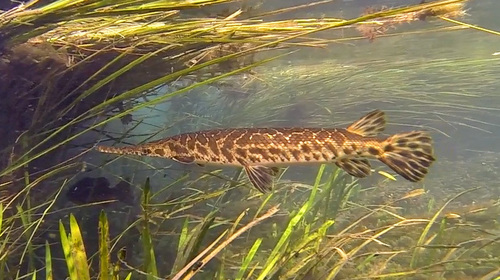
Spotted Gar
The Atlantic bluefin tuna (Thunnus thynnus) is a highly migratory, large predatory fish renowned for its size, speed, and commercial value. It plays a crucial role in the marine ecosystem and faces significant conservation challenges.
4 18 years
Lifespan
60 - 90 cm
Length
Least Concern
Conservation Status
5 km/h
Swimming speed
Carnivorous
Diet
Local Migration
Migration
Appearance Overview
The Atlantic bluefin tuna is a large, streamlined fish with a metallic blue body and a silvery-white underside.
Color
Dark metallic blue on top, silvery-white underside
Body Shape
Torpedo-shaped, built for speed and endurance
Fins
Two dorsal fins, the first depressible; small finlets behind dorsal and anal fins
Length
Up to 13 feet (4 meters)
Weight
Up to 2,000 lbs (907 kg)
Diet
Carnivorous, feeding on a variety of fish, squid, crustaceans, and eels.
Feeding Behavior
Aggressive predators, they use their speed and agility to hunt, often working cooperatively to herd and capture prey.
Social Behavior
Highly migratory, forming large schools, especially during spawning season. They exhibit complex social behaviors.
Commercial Relevance
Extremely high value, particularly in the Japanese sushi and sashimi market, where a single fish can fetch hundreds of thousands of dollars.
Conservation measures
Subject to international fishing quotas and regulations managed by organizations like ICCAT. Marine protected areas and efforts to reduce bycatch are also in place.
Status
Endangered (Varies by population segment; some are considered critically endangered)
Threats
Overfishing (historically and continuing), bycatch in fishing gear, climate change affecting prey distribution and spawning habitats.
Habitat Distribution
Depth Range
0-1,000 meters (typically found in the upper few hundred meters)
Geographic Range
Atlantic Ocean, Mediterranean Sea, Gulf of Mexico
Preferred Environment
Temperate and subtropical waters; pelagic (open ocean), often near continental shelves and slopes
Reproduction and Life Cycle
Breeding Habits
Spawns in warm waters, primarily in the Mediterranean Sea and the Gulf of Mexico, during specific seasons.
Development Stages
Eggs hatch into larvae; larvae develop into juveniles, gradually maturing into adults. Growth is relatively rapid in the early years.
Fecundity
Females are highly fecund, capable of releasing millions of eggs (up to 30 million) per spawning season.
Maturity Age
Matures at around 4-8 years, although this can vary depending on location and environmental conditions.
Faqs about Spotted Gar
How fast can Atlantic bluefin tuna swim?
Atlantic bluefin tuna are among the fastest fish in the ocean, capable of bursts of speed up to 40-60 mph.
What is the lifespan of an Atlantic bluefin tuna?
They can live up to 40 years, though this is becoming increasingly rare due to fishing pressure.
Are Atlantic bluefin tuna warm-blooded?
Yes, they are warm-blooded, unlike most fish. They maintain a body temperature higher than the surrounding water, which helps with muscle efficiency during hunting.
How much does a bluefin tuna cost?
The price varies greatly depending on size, quality, and market demand, but individual fish have been sold for hundreds of thousands, even millions, of dollars.
Where can I find Atlantic Bluefin Tuna?
They are found in the Atlantic Ocean, from the Mediterranean Sea to the Gulf of Mexico and the coasts of North America and Europe.
What advantage does warm-bloodedness give the Atlantic Bluefin Tuna?
Their warm-bloodedness allows for efficient muscle function in cold water, enabling high-speed swimming and deep diving.
Where does the Atlantic Bluefin Tuna spawn?
Spawning primarily occurs in the Mediterranean Sea and the Gulf of Mexico, with specific areas and times varying slightly.
Which organization manages Atlantic Bluefin Tuna populations?
ICCAT (International Commission for the Conservation of Atlantic Tunas) is the primary organization responsible for their management.
Copyright @ Nature Style Limited. All Rights Reserved.
 English
English